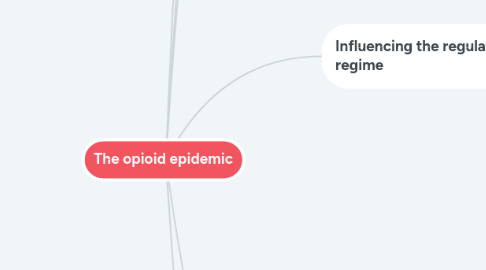
1. Relevant historical factors
1.1. Arthur Sackler’s marketing career
1.1.1. Featuring doctors as source of credibility in ads
1.1.2. Rise of medical marketing
1.1.3. Creation of medical publication
2. Structural factors
2.1. FDA approval process
2.1.1. FDA does not conduct clinical trials
2.1.2. Pharma companies conduct their trials and pay the FDA for approval
2.2. Patent expiration
2.2.1. Potential competition
2.2.2. Potential development of generics
3. Changing the culture on opioid prescription
3.1. Combating the limited use of opioids
3.1.1. End of life care
3.1.2. Short-term pain (post-surgery, cancer)
3.2. Educating the medical community
3.2.1. Use of key opinion leaders (KOLs)
3.2.1.1. Use of doctors as credible sources
3.2.1.2. Use of medical advertising in journals
3.2.1.3. Use of owned medical journals
3.2.2. Provide perks to doctors
3.3. Eliminating the stigma of opioid prescription
3.3.1. The “less than 1%” statistic
3.3.2. The promotion of a “pain epidemic”
3.3.2.1. Expand the medical conditions treated by opioids
3.3.3. Pain as 5th vital sign
3.4. Promoting the drug
3.4.1. Large number of sales representatives
3.4.1.1. Large bonuses as incentives
3.4.2. Production of videos and materials
3.4.3. Organization of conference with paid speakers
3.4.4. Coupons
4. Influencing the regulatory regime
4.1. Creation and funding of the astroturf groups
4.1.1. American Pain Foundation
4.1.2. The American Pain Society
4.1.3. The American Academy of Pain Medicine
4.2. Creation of Political Action committees (PACs)
4.2.1. Political contributions to federal legislators
4.2.2. Political contributions to state legislators
4.3. Lobbying
4.4. Executives on the FDA advisory board and other agencies
4.5. Philanthropy
4.5.1. Academic
4.5.2. Medical
4.5.3. Arts
5. Strategies when things go bad
5.1. Blame the patients
5.1.1. Pseudo-addiction
5.1.2. Diversion
5.1.3. Misuse
5.2. “Sell through it”
5.2.1. Ignore abuse reports
5.2.2. Ignore data on ineffectiveness and overprescription
5.2.3. Suppress negative coverage
5.3. Settle lawsuits
5.3.1. No documents disclosure
5.3.2. No admission of guilt
5.4. Increase political influence
5.4.1. Political contributions
5.4.2. Astroturf groups
5.4.3. Lobbying
5.5. Sue critical practitioners
5.6. Expand the market
5.6.1. Oxycontin for kids
5.7. Go global
5.7.1. Use the same marketing strategies used in the US
6. Consequences
6.1. Addiction epidemic
6.1.1. high overdose rate
6.2. Demographics of the epidemic
6.2.1. White, middle class
6.2.1.1. Pain taken seriously by doctors
6.2.1.2. Have insurance
6.2.2. Minority, urban less affected
6.2.2.1. Racial prejudice: pain taken less seriously
6.2.2.2. Less covered
6.3. Heroin and fentanyl epidemics
6.3.1. Most addicts started on prescription pain medication
6.3.2. Overprescription led to crackdown
6.3.2.1. CDC warning
6.3.2.2. Insurance stops coverage
6.3.2.3. Criminal organizations benefit from demand
